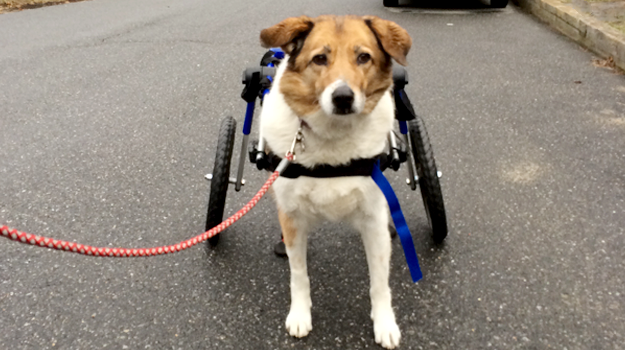Degenerative Myelopathy in Dogs: Symptoms and Treatment

What is Degenerative Myelopathy?
Canine Degenerative Myelopathy (DM) is a progressive disease of the spinal cord and ultimately the brain stem and cranial nerves which, at its end stages, results in complete paralysis and death. The closest human equivalent may be Amyotrophic Lateral Sclerosis, or ALS, also known as Lou Gehrig’s disease. The same gene mutation is implicated in both diseases.
DM was first described as a specific neurological disease in 1973. The cause of the disease is linked to a genetic mutation in the SOD1 gene. The mutated gene has been found in 100 breeds including Cardigan and Pembroke Welsh Corgis, Chesapeake Bay Retrievers, Irish Setters, Boxers, Collies, German Shepard Dogs, and Rhodesian Ridgebacks. In a recent study 2% of German Shepard Dogs were identified as having the disease. Only 0.19% of dogs in general have the condition.
The disease typically appears at between 5 and 14 years of age depending on the breed of dog, but most dogs are at least 8-9 years old. Both sexes appear to be equally affected.
What is Actually Happening?
DM begins in the spinal cord in the thoracolumbar (behind the shoulder blades to the mid-low back) region. The white matter of the spinal cord, which contains the nerve fibers responsible for transmitting movement commands from the brain to the limbs and sensory information from the limbs to the brain, degenerates. The degeneration consists of demyelination of the nerves and actual loss of nerve fibers. If you think of the nerve fibers as an electric wire, the myelin (a white fatty material that surrounds the nerve fibers) would be the insulating coating on the outside of the wire. Without this coating, nerve impulses cannot be transmitted.
According to Dr. Joan R. Coates, one of the leading experts in this condition, DM is similar to oxidative stress which characteristically has a release of free radicals resulting in cell degeneration.
Symptoms/Warning Signs
Degenerative Myelopathy has a slow, insidious onset with a slow progression of weakness. It is not uncommon for the signs to progress slowly, plateau, and then start to progress again. These symptoms often begin in one rear leg and then eventually involve both rear legs as the disease progresses; alternatively, it could affect both rear legs at the same time. This condition is NOT painful. As a result, with appropriate physical therapy and nursing care, patients with DM can still have a good quality of life for a significant length of time. Eventually, dogs will become unable to bear weight in the back legs and may need a cart to move around. Incontinence will develop and later the front legs become affected.
diagnosis
DM is diagnosed presumptively through genetic testing. Blood or a cheek swab is sent to the lab and evaluated for the genetic marker. There are three possible test results: N/N – both copies of the gene are normal, and the dog does not have DM. N/A – the dog has one normal copy of the gene and one abnormal/affected copy of the gene. Most dogs with this outcome will not develop DM; however, care should be taken to not breed two N/A dogs as this may result in a litter with dogs at risk for DM. A/A – this means the dog is at risk/affected with DM. It is important to rule out other diseases that could mimic DM via MRI and CSF analysis; however, if no other cause is found and the dog is A/A, they most likely have DM. It is important to note that not all dogs that test positive for the A/A genotype will develop DM.
Treatment
- Exercise will help to prolong you dog’s muscle mass and mobility.
- Aquatic therapy of either walking or swimming can even be more useful than walking. To date, professional canine rehabilitation (physical therapy) is the only treatment that has been shown to improve quality of life and longevity.
- Increased awareness of the level of nursing care necessary to prevent secondary complications such as decubitus ulcers, urinary tract infections and foot damage is also very important.
- The use of a harness to assist in your dog’s mobility and later in your ability to move your dog around are also considerations.
- A cart or a progression of carts will not only improve your dog’s mobility but his or her quality of life.
- Dr. Roger M. Clemmons, suggests that a combination of “diet, exercise, supplements and medications” may “slow or stop the progression of the clinical signs.” These statements have not been confirmed by peer-reviewed, controlled studies. Anecdotally, we have seen no significant difference in patients that were given these supplements/medications compared to those patients that did not receive them.